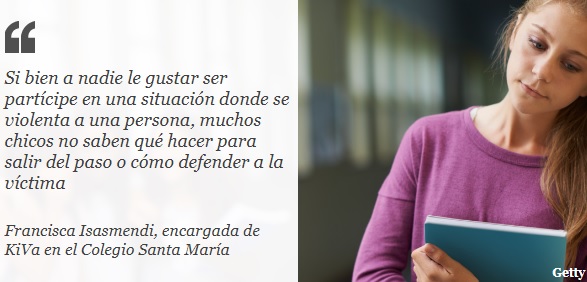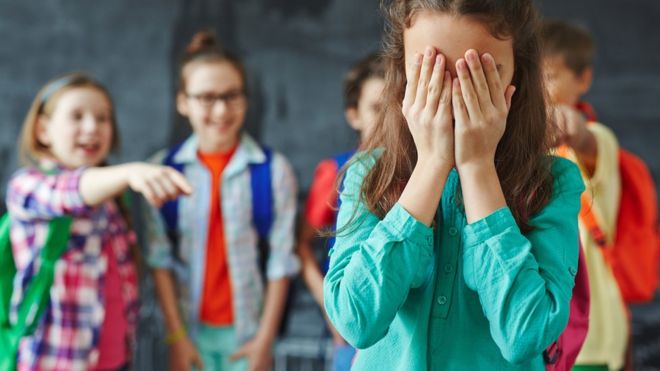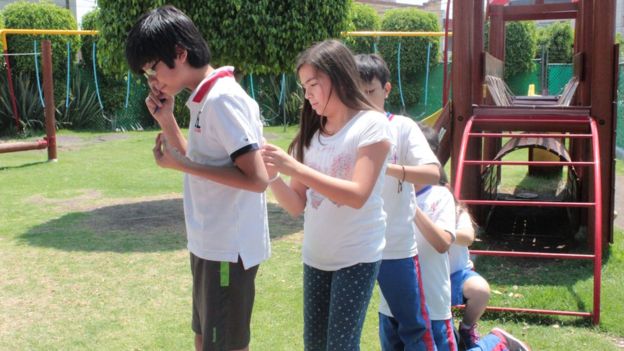BBC News Coverage of our Director about school harassment prevention
Our Principal, Iván Galindo, traveled to Finland to learn about the Finnish educational system and visited several elementary schools, universities, research centers, schools for people with disabilities and the University of Turku where the KIVA system, an anti-bullying program, was created. school that has begun to spread in schools in Latin America and we had the program from 2017 until 2022.
Below we share the report published in 2017 by the BBC MUNDO on its news site and where Iván Galindo talks about the prevention and awareness work that has been achieved at the School.

How is KiVa, the successful method created in Finland to combat bullying that is starting to be used in schools in Latin America
It doesn't matter if they are private or public, if they are in privileged neighborhoods or poor areas, in China, United Kingdom or Uruguay. In most of the world's schools, situations of bullying or harassment are generated to a greater or lesser extent.
Finland, a leading country in education, is no exception to the rule.
However, since 2009 , bullying in that country's schools has decreased dramatically thanks to a revolutionary method to combat these situations in which a student or group of students systematically harasses a fellow student.
According to a study involving 30,000 students between the ages of 7 and 15, this system developed at the University of Turku in southwestern Finland succeeded in eliminating bullying in about 80% of schools and reducing it in the other 20%.
 ERIK ERIKSON
ERIK ERIKSONThe success of this program called KiVa (acronym for Kiusaamista Vastaan, which in Finnish means against bullying) did not go unnoticed in Europe, where about 20 countries decided to implement it.
And now, several educational institutions in Latin American countries -including Argentina, Chile, Colombia and Perú- are beginning to use it.
The role of witnesses
The key to KiVa is that, unlike traditional methodologies, in addition to working with the victims and the harassers, it "incorporates the witnesses," Francisca Isasmendi, a psycho-pedagogue and head of the program at the Santa María School in Salta, one of the pioneering institutions in the implementation of KiVa in Argentina, tells BBC Mundo.
In other words, "it takes into account people who remain silent and suffer passively from harassment".
"Because even though nobody likes to be part of a situation where a person is being violated, many kids don't know what to do to get out of the way or how to defend the victim," adds Isasmendi.
Although the witnesses are not the obvious protagonists of the story, with their silence or their laughter they reinforce the power of the aggressor.
If you work with observers so that they become aware of their role in this situation and they modify their behavior, the offender loses his audience. ECLAC and Bullying Without Borders (2014)
"And when the group stops supporting him and he is left alone, the bully stops," explains the psychopedagogist.
Once a bullying situation is identified in the class, a trained team works following a specific protocol with the victim, the bully and the witnesses individually, without confronting them.

"The impact of the system is felt above all by the bullies, because if they change the attitudes of others, (bullying) is no longer as much fun," Tiina Mäkelä, director of the KiVa program at the Escalae Institute in Spain and trainer of the program in Spanish-speaking countries, told BBC Mundo.
Before it happens
Another fundamental component -in which everyone participates- is prevention.
"This includes lessons and activities that are given twice a month, for 45 minutes, where we do not talk about particular cases but about general concepts," says Tiina Mäkelä.
All these activities aim to create a friendly, generous and respectful environment for others.
Children are taught to differentiate between a peer conflict (acceptable) and a bullying situation, which should not be tolerated.
Ivan Galindo, owner and director of the Erik Erikson School in Queretaro, two hours from Mexico City, says that acting before bullying situations develop was important in improving the well-being of the children in his school.
"We used to act when we realized something was happening, when the milk had already been spilled," he tells BBC Mundo.
"Now we anticipate the problem and it is easier to identify it, because the children already know what it is," and how to avoid it, he explains.

Isasmendi agrees with Galindo.
The kids know now that if they are in a situation where they don't feel comfortable or they feel violated they can ask for help," says Isasmendi.
And this prevention and awareness work also reaches parents and teachers.
"We have to change the culture, because here bullying is often taken as something normal and they say 'it's a child's thing, let them solve it among themselves'. And, as a consequence, many children go through all their schooling feeling bad", explains the psycho-pedagogue.
 ERIK ERIKSON
ERIK ERIKSONIsasmendiIsasmendi recognizes that it is a slow work but that it gives results, although paradoxically now, according to her experience, there seems to be more cases.
It is not because they did not occur before, she clarifies, but "now they are seen more because there is a greater awareness that it is not normal for this to happen.
From Finland to Latin America
But to what extent can a method created for a culture and a society so different from ours provide the same results?
"There are basic problems that are the same in all countries," says Mäkelä, although she acknowledges that certain aspects of the methodology require more attention here.
"Teachers here need more support than in Finland because they have more autonomy and more time to prepare their classes.
Another point is collaboration with families.
"Many times in Latin America, instead of collaborating, we look for the culprits: the family blames the school and vice versa. Instead of looking for blame, we have to look for solutions," adds Mäkelä.
In the case of the school in Salta, involving the families helped speed up the changes.
"Nosotro"We needed the families to participate because we noticed that when they did, we saw much faster changes," says Isasmendi.
A little more than a year after its implementation, it is still early to quantify KiVa's impact in Argentina, but judging by the testimonies of students and teachers, the improvement in the school environment is evident.
"(Kiva) makes me feel safer and more confident. KiVa's classes made me more empathetic and more social," says a 4th grader at Erik Erikson School.
"It has motivated students to be more reflective and to take more notice of each other," says a coordinator at the same institution.
For Isasmendi, it is much more than a valid tool to intervene in a school environment.
"It is more than an anti-bullying program. It is a philosophy of life that aims at school welfare, to create a working environment where children can have tolerance and respect.





 Derechos de autor de la imagen
Derechos de autor de la imagen Derechos de autor de la imagen
Derechos de autor de la imagen Derechos de autor de la imagen
Derechos de autor de la imagen Derechos de autor de la imagen
Derechos de autor de la imagen Derechos de autor de la imagen
Derechos de autor de la imagen Derechos de autor de la imagen
Derechos de autor de la imagen